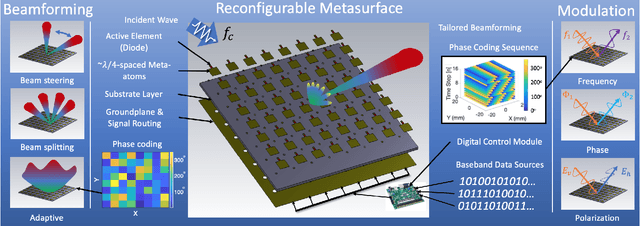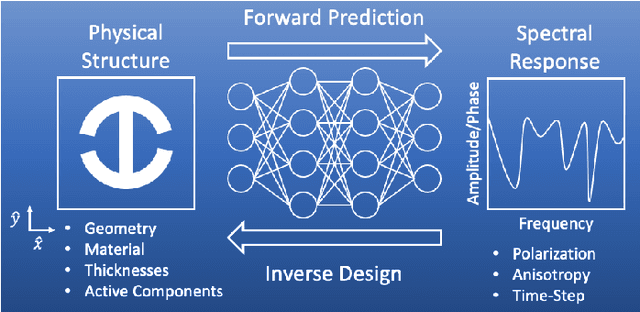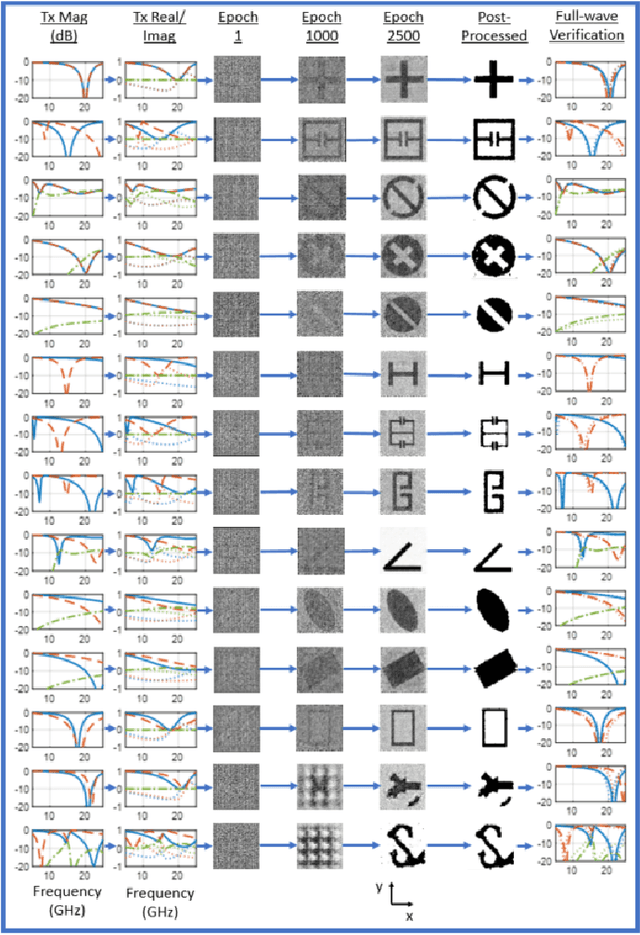Amir I. Zaghloul
Index-Modulated Metasurface Transceiver Design using Reconfigurable Intelligent Surfaces for 6G Wireless Networks
Oct 04, 2023Abstract:Higher spectral and energy efficiencies are the envisioned defining characteristics of high data-rate sixth-generation (6G) wireless networks. One of the enabling technologies to meet these requirements is index modulation (IM), which transmits information through permutations of indices of spatial, frequency, or temporal media. In this paper, we propose novel electromagnetics-compliant designs of reconfigurable intelligent surface (RIS) apertures for realizing IM in 6G transceivers. We consider RIS modeling and implementation of spatial and subcarrier IMs, including beam steering, spatial multiplexing, and phase modulation capabilities. Numerical experiments for our proposed implementations show that the bit error rates obtained via RIS-aided IM outperform traditional implementations. We further establish the programmability of these transceivers to vary the reflection phase and generate frequency harmonics for IM through full-wave electromagnetic analyses of a specific reflect-array metasurface implementation.
Machine Learning for Metasurfaces Design and Their Applications
Nov 02, 2022Abstract:Metasurfaces (MTSs) are increasingly emerging as enabling technologies to meet the demands for multi-functional, small form-factor, efficient, reconfigurable, tunable, and low-cost radio-frequency (RF) components because of their ability to manipulate waves in a sub-wavelength thickness through modified boundary conditions. They enable the design of reconfigurable intelligent surfaces (RISs) for adaptable wireless channels and smart radio environments, wherein the inherently stochastic nature of the wireless environment is transformed into a programmable propagation channel. In particular, space-limited RF applications, such as communications and radar, that have strict radiation requirements are currently being investigated for potential RIS deployment. The RIS comprises sub-wavelength units or meta-atoms, which are independently controlled and whose geometry and material determine the spectral response of the RIS. Conventionally, designing RIS to yield the desired EM response requires trial and error by iteratively investigating a large possibility of various geometries and materials through thousands of full-wave EM simulations. In this context, machine/deep learning (ML/DL) techniques are proving critical in reducing the computational cost and time of RIS inverse design. Instead of explicitly solving Maxwell's equations, DL models learn physics-based relationships through supervised training data. The ML/DL techniques also aid in RIS deployment for numerous wireless applications, which requires dealing with multiple channel links between the base station (BS) and the users. As a result, the BS and RIS beamformers require a joint design, wherein the RIS elements must be rapidly reconfigured. This chapter provides a synopsis of DL techniques for both inverse RIS design and RIS-assisted wireless systems.
* Book chapter, 70 pages, 12 figures, 2 tables. arXiv admin note: substantial text overlap with arXiv:2101.09131, arXiv:2009.02540
Constant Curvature Curve Tube Codes for Low-Latency Analog Error Correction
May 24, 2022



Abstract:Recent research in ultra-reliable and low latency communications (URLLC) for future wireless systems has spurred interest in short block-length codes. In this context, we introduce a new class of high-dimension constant curvature curves codes for analog error correction of independent continuous-alphabet uniform sources. In particular, we employ the circumradius function from knot theory to prescribe insulating tubes about the centerline of constant curvature curves. We then use tube packing density within a hypersphere to optimize the curve parameters. The resulting constant curvature curve tube (C3T) codes possess the smallest possible latency -- block-length is unity under bandwidth expansion mapping. Further, the codes provide within $5$ dB of Shannon's optimal performance theoretically achievable at the lower range of signal-to-noise ratios and BW expansion factors. We exploit the fact that the C3T encoder locus is a geodesic on a flat torus in even dimensions and a generalized helix in odd dimensions to obtain useful code properties and provide noise-reducing projections at the decoder stage. We validate the performance of these codes using fully connected multi-layer perceptrons that approximate maximum likelihood decoders. For the case of independent and identically distributed uniform sources, we show that analog error correction is advantageous over digital coding in terms of required block-lengths needed to match {signal-to-noise ratio, source-to-distortion ratio} tuples. The best possible digital codes require two to three orders of magnitude higher latency compared to C3T codes, thereby demonstrating the latter's utility for URLLC.
Deep Inverse Design of Reconfigurable Metasurfaces for Future Communications
Jan 22, 2021



Abstract:Reconfigurable intelligent surfaces (RIS) have recently received significant attention as building blocks for smart radio environments and adaptable wireless channels. By altering the space- and time-varying electromagnetic (EM) properties, the RIS transforms the inherently stochastic nature of the wireless environment into a programmable propagation channel. Conventionally, designing RIS to yield the desired EM response requires trial-and-error by iteratively investigating a large possibility of various geometries and materials through thousands of full-wave EM simulations. In this context, deep learning (DL) techniques are proving critical in reducing the computational cost and time of RIS inverse design. Instead of explicitly solving Maxwell's equations, DL models learn physics-based relationships through supervised training data. Further, generative adversarial networks are shown to synthesize novel RIS designs not previously seen in the literature. This article provides a synopsis of DL techniques for inverse RIS design and optimization to yield targeted EM response necessary for future wireless networks.
 Add to Chrome
Add to Chrome Add to Firefox
Add to Firefox Add to Edge
Add to Edge